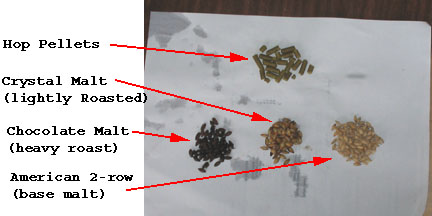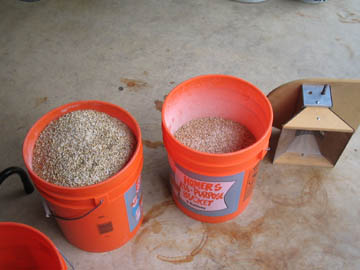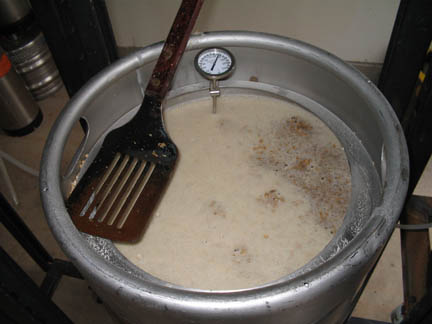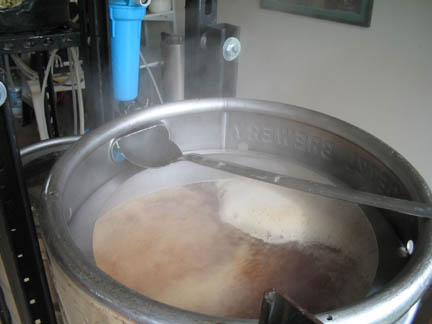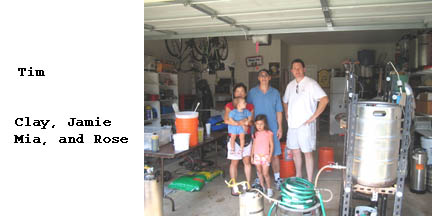Brewing
Great Beers!!!

|
|
Beer is proof that God
loves us and wants us to be happy- Benjamin Franklin
After more than 4 years in Germany, coming back to the United States was a
big shock. I'm just not a crappy, tasteless beer fan. My very close friend,
former neighbor, and professional brewer, David Huls, is 80% responsible for
me diving into brewing; the other 20% is due to loving good beers. We started
brewing together in 1998 and Big Dave got so into it that he got his brewing certificate from
UC-Davis and went pro. He's now a Master Brewer for Gordon Biersch.
Big Dave is a Silver Medal winner in the Great American Brew Fest for his
Strong Scotch Ale!!! If you
are considering brewing, finding a good friend and beer mentor like Dave is
important as well as finding the local brew stores. Up in Dallas?, Kelly and
his team at Homebrew Headquarters has
been very helpful for bouncing things off of, getting equipment, and fresh
hops. Living in Austin, I have found that Austin Homebrew is a great home brew
shop with an extremely helpful staff. Joining a home-brew club is a good idea
as you'll learn a lot from more experienced brewers and may even have the
opportunity of helping out newbies. I am currently
a member of the Austin Zealots
homebrew club. My
brewing is all-grain, which means I mix several types malted barley depending
on the malt profile and taste I want to achieve, and ("mash") the
grain with a malt mill I
separate the liquid from the spent grain, boil and add the finest hops money
can buy. The boiling liquid (“called wort at this
point”) is then cooled and transferred to fermenters. I then float wonderful little yeasts in the
wort, to produce the best beers known to this
corner of Austin. I can say that because now that Big Dave has gone pro, he
doesn't home brew as much...just teasing Dave...anyway, the yeast consume the
sugar produced during the mashing process and convert that sugar to alcohol
and CO2. Let's
take a look at some of the steps and the equipment. The first step is to
decide what style of beer that you want to produce, or if the beer you are
designing will hit any pre-defined style. There are two main categories of
beer commonly recognized: ales and lagers. Ales are fermented with yeast that
favor warm temperatures around 65-75 °F and Lagers are fermented with yeast
that favor colder temperatures around 48-54 °F. Ales ferment faster and have
fruitier notes due to the esters and fusels produced by yeast during the
relatively fast fermentation, about 2 weeks, whereas lagers tend to be
cleaner in taste and ferment much slower, taking a month or more to ferment. Whether
an Ale or a Lager decision, when designing the next great beer, you also need
to take into account season, maltiness, dryness,
darkness, lightness, bitterness, aroma, head retention, etc...but is hopefully up to your tastes. I love all sorts of
different brews and, fortunately enough, have the use of our chest freezer to
control fermentation temps. That simply means that I can ferment at higher
temps for an Ale or lower temps for a Lager. Here is
an example of some of the ingredients: Ingredients
For the
most part, a base malt (2-row, pilsner, vienna) makes up the largest portion of malt you will
use. As an example, for an IPA, I'll use 22 lbs of American 2-row as the base
malt. There are many malts that can be used it impart flavor and color to a
beer. 2 are shown above, 40 Lovobond Crystal Malt
and Chocolate Malt. Brewers use the variety of base and specialty malts to acheive the malt character, color, and head retention
characteristics when designing a great beer. Hops are
used in the boil to add bitterness, flavor and aroma to your beer, balancing
the maltiness and providing a clean finish to your
beer. Once you
have decided on what you want to brew, then it's time for recipe formulation.
I use a program called ProMash
to help with calculations and adjustments during the recipe formulation and
brewing process. I've included my favorite recipes (see favorite recipe
links). Milling Grain with Malt
Mill and Trusty Dewalt
Milled Grain with Malt
Mill
Mash Tun Once the
grain is milled, you heat water to an appropriate temp (range of 146 °F to
162 °F, depending on beer style) to activate enzymes; alpha and beta amylase,
which break down starches into sugars. Basically, we are making yeast food.
Yeast break down the sugars into alcohol and CO2. Without getting too geeky,
brewers use temperature to tune the malt profile within the above range;
148-152 °F yields a more fermentable wort and drier
beer (think pale ales and pilsners) whereas 155-160 °F yield a less
fermentable wort delivering more complex, maltier beer (think bocks and brown ales). So
temperature control is critical, If the temp is too cold, the enzymes will
not activate, and if the temp is too hot, you will denature the enzymes and
won't be able to recover the process. The ProMash
software helps me make these critical temperature calculations. I try to hit
a "strike" temp that is about 20°F to 25°F hotter than the target
temp in that I know I will loose some temp due to
pumping water into a cold keg and introducing cold grain into the hot water.
The ProMash software helps me do these
calculations. Once the appropriate amount of hot water is pumped across into
the mash tun, I mix in the milled grain. Note that
the mash tun has a false bottom. The grain settles
on the false bottom and acts as a natural filter. Water is heated in the hot
liquor tank tank to the right in the picture below,
and then transfered to the mash tun
(keg in the middle). Brew Rack The
figure above gives an overall view of my brew rack and brewing equipment. My
system comfortably produces 10 gallon batches. My mash/lauter
tun is in the middle, with the sparge
tun high to the left for gravity-based flow in sparging. I heat water in the hot liquor tank, to the
right. The Mash in the Center
Tank
Once the
grain has steeped in the water for about an hour, really whatever time it
takes for the starch to sugar conversion and color extraction, it is time for
("mashing out"). In the mash-out process, the grain is rinsed with
hot water, usually around 172°F , in a process
called sparging. At the same time, the liquid is
very slowly pumped into the hot liquor tank for boiling. Slow, deliberate
run-off from the lauter tun
to the hot liquor tank is one of the most important steps, and helps to
ensure the best extraction of sugars from the grain bed. Once in the hot
liquor tank, the extraction is called Wort. Mashing Out There I
am mashing-out. Note the sparge arm from the sparge tank goes into the top of the lauter
tun, and out of the bottom of the lauter tun, I am adjusting the
flow of the runnoff into the hot liquor tank. This
process is aided by the food grade pump. I'll let about 10 gallons of wort come across, stop the process and use a hydrometer
to check the amount of sugar in solution. The amount of sugar in solution is
important in that it shows how efficient the mashing process was and also is
a good indicator of what alcohol content the beer will eventually have. If I
have done everything correctly, and the run-off was controlled, I can go
ahead and continue the run-off to 12 1/2 gallons for the boil. At that point,
I will use a hydrometer to check the wort again. I
can expect that I am going to loose 2 gallons of wort to evaporation during the boil. Boiling
is done to sterilize the wort. As mentioned
earlier, Hops are added during the boil to provide bittering,
hop flavor, and aroma. Boiling (right-side
tank)
Whatever
you do, USE FRESH HOPS!!! Bittering additions are
done fairly early in the boil to extract and break down certain resins in the
hops, flavoring in the middle, whereas aroma hop additions are added late or
at the end of the boil. There are as many variety of
hops to use as there are malts. The type you use should be typical of the
style of beer you are brewing, however,
experimentation is the fun part of being a home brewer. Racking Off into Fermentation
Vessels The hot wort flows through a Counter-Flow Chiller. This is a
contraption that I built based on instructions found on the internet with
help from Dave. We wind 20' of 1/4" flexible copper tube through a standand garden hose. The hot wort
flows through the copper tube while at the same time, cold water flows around
the copper allowing heat to be transferred to the cold water. When the wort hits the fermentation vessel, it's
temperature is about 1 or 2 degrees above the water temperature. The reason
for a chiller is to bring the wort temperature down
to a temperature that won't kill the yeast that are about to be pitched into
the fermentation vessels. Without a chiller, you would have to wait several
hours to a day for the wort to adjust to a
non-lethal, usable temperature. As can be
seen above, I use a chest freezer as a fermenter. My
wife is none-to-happy about this, but a chest
freezer with a temperature controller is a great fermenter
because it is so well insulated. I can ferment ales at 65 °F to 68 °F,
ferment lagers at 48 °F to 55 °F, crash beers to freezing, and can force
carbonate at 32 degrees. All due to a chest freezer and Johnson temperature
control unit. Yeast consume sugars and produce two things; CO2 and alcohol. A
brewer can choose to vent the CO2 as I do with the blow-off hoses and the
bucket of bleach water, or naturally carbonate by not venting the
fermentation vessels. I choose to vent the CO2 for a variety of reasons: Nope, I
don't bottle (that's a pain in the bass-ale...). For most light colored beers,
I will use a brew-plate filter from Williams Brewing (see link) to clarify
and polish my beers. For darker beers, it really isn't necessary and I just
rack the fermented beer off to another Corny keg for serving. I push the beer
with 20 lb. CO2. Beer Friends (adults -
you think I'm that crazy...) - Waiting for a free sample
Favorite Recipes Okay, so
I'm an Italian brewer that likes to name beers, but this American Style Pale
Ale Hop Monster packs one heck of a hops punch. For special fun, try
dry-hopping this powerful beer with either Amarillo or Cascade hops. Use a
single-step, infusion mash and hit a strike temp of 152 °F and you'll be on
the money for a clean-tasting beer meant for your favorite hop-head. Note the
use of a small amount of Carapils Dextrin Malt. I
use 1/2 pound for body, mouthfeel and head
retention. I have to tell you, this is one of my wife's favorite beers.
It never
fails that when I am brewing this beer, no matter the season, a few bees come
out to take a wiff of the boil. I grab my trusty
brewing spoon and bat the little bastards into the boiling wort (I better watch out for those crazed PETA
whacko's...). Thus the name for this wonderful American-style brown ale. You
want to accentuate the malt character on this beer, so your strike temp
should be about 156 °F degrees.
Petden, in Satellite Beach Florida, is where I cut my surfing teeth. Petden was the hotest spot in
town for surf and for some strange reason (fantasizing about my mis-spent youth maybe...) I think of Petden
when I drink this brew. Petden Porter shows off a roasty chocolate and nutty
90-Lovibond Crystal malt, which is just rippin hot.
A-Framers and Mark Reality beach folks were bud drinking gremmies. This
Porter is much like a day at Petden; the first beer
is a smooth paddle out on a fall to winter day and what follows are toasty
waves to the end. An interesting twist to this beer is to pour in a pot of
coffee or steep coffee grounds in the secondary (Chris Colby - thanks for the
tip) to create a Coffee-Porter. You want to accentuate the malt character on
this beer, so your strike temp should be about 156 °F degrees.
I said
Dude...he said, Dude...we said Dude!!! This is just a fun, easy going, summer
beer. The fun part is mixing a decidely German malt
bill with hops similar to an American Pale Ale...and San Francisco Lager
yeast...what a mix...A little bit of something for everyone, beach sitter,
long-boarder, short-boarder, republican, democrat, or middle of the fencer..except I don't think a dem would
never brew... they'd just come by and consume... Anyway, whatever your board
or politics, use a single-step infusion mash with a target of 152°F
This beer
is brewed in honor of my Son-in-law, Bobby Skeen and also Stevey-Ray
Vaughn. It's a long story, but suffice it to say,
the first time we met Bobby, he locked horns with the Dubbel
and the Dubbel won!!! This Belgian is a strong
beer, with a bubble-gum nose that really warms a cold Dallas January. Okay,
so it's not that cold in Dallas, so what, drink up!!!
Mai-oh Maibock AKA Catalano Crippler I have to
tell you, this is one of my favorite beers. I try to brew this in early
January and wait till May before tapping this hefty brew...never made it past
Feb 15. Maibock should be a strong and malty beer
with an amber tone and balanced noble hops. As you can tell from the recipe,
my interpretation has an uncharacteristically high IBU - more hops than the
style calls for. Well, that's the fun of homebrewing.
I like hops!!! This beer packs a bit of alcohol, with an OG of 1.072 and a
usual FG of 1.016. Careful now...
Audrey
(my wife) and I spent 4 1/2 years in Germany serving our country. What an
absolute kick in the pants that was. We just had a ball, and the German
pilsner beers were one of the reasons. Bitte ein Bit (please give me a Bitburger
Pils) was one of our favorites. Audrey also loves
pigs, so there you have it. Again note a high IBU...well, she LOVES hops,
too. This is
the only beer that I use a two-step mash process. For ales and most lagers,
this is a total waste of time. However, a pilsner needs to be super clean, so
I bring it to 145°F for 30 minutes with a thick mash for the beta-amylase
rest, and then pump more hot water in to bring the mash to 158°F for the
alpha-amylase rest. If you've got the equipment and can do it, okay,
otherwise hit a strike temp of 152°F and you'll be okay. Well, the lady wants
a pils, I better get brewing!!!
This beer
is named after the first peak break at Sebastian Inlet on the east coast of
sunny Florida. Did I tell you I surf... Anyway,
First Peak, like this beer, starts fast and big. It's a big malty bottom turn
with a clean roasty-toasty off the lip, that delivers all the way through, then a cut-back
for another. Totally tubular!!! This beer
boasts an alcohol by volume around 8%, which makes it a classic winter
warmer. Strong Scotch Ale's, aka Wee Heavy's, are known for having a hint of
smoky flavor delivered mostly through the yeast. I also use a Scottish Peated Malt, but only a very small amount as it is easy
to overdue and will overwhelm your beer. A First Peak, thinking about good
surf to come and a Green Bay game...well, it doesn't get much better...Give
Favre some blocking, dammit!!!
Festbier is another favorite...alright, you've guessed that they are all
favorites...I love beer, and so do you if you've read this far. This
wonderful meal in a glass is brewed to the Santiago Graf interpretation of
strong Vienna style festival beers. Think Negro-Modello.
Simply put, I throw a handful of chocolate malt in. This is a great fall brew
warmer that puts a crooked smile on the Halloween pumpkin.
Winter
Steamer is my attempt at going after Anchor's 1996 Christmas Ale...oh what a
beer that was. I think that you'll find this to be pretty close. With an 8%
alcohol by volume, this brew will cure the flew, colds and warm you to the core. Winter
Steamer is a spice beer, which shows off orange zest, cinnamon, ginger, correander, nutmeg and a hint of clove. The orange
zest/rinds (whatever) go in a steeping bag at 10
minutes into a 70 minute boil. My experience has shown that it takes a long
time for the orange oil flavor to assimilate into the boil. I add the spices
with 5 minutes left so that the spices provide aroma without overwhelming the
flavoring of the beer. Initially, this brew tastes like pumpkin pie in a
glass, but within a month mellows enjoyably. As with most high alcohol
content beers, especially spice beers, a couple of months of aging are
required.
Two
glasses of this hefty brew will have you singing that grand old Christmas
tune just as bad and as loud as me (believe me, I am a much better brewer
than singer). My wife gets a big kick out of this every year by hosting a
Christmas Holiday party and having me lead in singing Christmas carols. I'll
put it this way, my good friends come for the beer, not the singing... This beer
is modeled after Chimay Grande Reserve and boasts a
9 or so percent alcohol by volume. You may already be onto me here, Maibock, Festbier, Winter
Steamer, and then this wonder in a glass, seems a trend toward higher alcohol
content brews...you'd think I lived in freakin'
Minnesota. Okay, one of the joys of home brewing is being able to target a
certain seasonal or specialty brew and then going after it. Due to the amount
of grain required for this beer, I just brew a 5 gallon batch (it's hard to
fit 43 lbs of grain into a 15 gal keg 1/2 full of hot water)...
Have a Berry, Berry
Christmas Ale This is
my Christmas Ale for 2004 and 2006. Originally brewed it turned out better
than I could have imagined, so this year I threw in 2 lbs more frozen rasberries in. I will definitely brew this again as it is
crisp, full of alcohol for sipping during frigid Austin Texas winters. The
wife likes it, Big Dave has given it his blessings,
and neighbors from all around have become new friends after quaffing this
puppy. The base
for this fruit beer is an Imperial Pale ale. I threw
in about 8 lbs of frozen rasberries directly into
the fermenters for a 10 gallon total batch. To
ensure that the rasberries would not infect the
beer, I steamed them for roughly 5 minutes; not long enough to loose any flavor, but long enough to hopefully rupture
cell walls of wild yeast or bacteria. Then I pitched fresh yeast (White labs
051) on top and let 'er rip. Note to self: the rasberries contain fermentable sugars (fructose), which
will add to the original gravity. Man, there is some alcohol in this
flavorful brew!!! From a
recipe formulation perspective, I made the assumption that sugar represents 8
percent of the weight of the rasberries. So when
you see rasberries and only about 1 lb of sugar,
understand that represents 8-10 lbs of rasberries.
|
|||||||||||||||||||||||||||||||||||||||||||||||||||||||||||||||||||||||||||||||||||||||||||||||||||||||||||||||||||||||||||||||||||||||||||||||||||||||||||||||||||||||||||||||||||||||||||||||||||||||||||||||||||||||||||||||||||||||||||||||||||||||||||||||||||||||||||||||||||||||||||||||||||||||||||||||||||||||||||||||||||||||||||||||||||||||||||||||||||||||||||||||||||||||||||||||||||||||||||||||||||||||||||||||||||||||||||||||||||||||||||||||||||||||||||||||||||||||||||||||||||||||||||||||||||||||||||||||||||||||||||||||||||||||||||||||||||||||||||||||||||||||||||||||||||||||||||||||||||||||||||||||||||||||||||||||||||||||||||||||||||||||||||||||||||||||||||||||||||||||||||||||||||||||||||||||||||||||||||||||||||||||||||||||||||||||||||||||||||||||||||||||||||||||||||||||||||||||||||||||||||||||||||||||||||||||||||||||||||||||||||||||||||||||||||||||||||||||||||||||||||||||||||||||||||||||||||||||||||||||||||||||||||||||||||||||||||||||||||||||||||||||||||||||||||||||||||||||||||||
